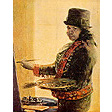
Goya's subject matter







Goya was not a traditional painter: on the contrary, from an early age he broke away from the established modes of his day Self-portrait working at night |
Goya was a versatile artist who worked with ease in various genres in painting, drawing and etching. He painted works of an allegorical and mythological nature. However, the greater part of his work consisted of religious art, studies of contemporary life and portraiture.
Don Francisco was not, however, a traditional painter. On the contrary, from an early age he broke away from the established modes of his day. From the beginning of his career, his studio paintings were such that, with the passage of time,they became studies of the nature of composition. The first studies that have been conserved were the small paintings he made in Luzán's studio, his Italian sketchbook and his copies of Velazquez, all of which are testimonies of the apprenticeship of an artist that soon to become one of the greatest artists in the Western tradition. However, his passion for learning new techniques put him amongst the ranks of the avant garde. At the end of the 18th century, Goya embarked on a series of paintings and etchings full of imagery and personality, which were called the Caprichos (a term meaning caprice, invention) which made no concession to the fashions required by commissioned work. Little by little, his love of innovation would invade and fertilize the totality of his work. During his time as painter for tapestries, a job which required the study of conventional themes, Goya committed himself to the pictorial study of his characters. In his first studies of daily life, the customs and fashions of the day were painted without comment and Goya pandered to the tastes and requirements of his clients. However, by the end of the century, Goya was working on themes from the War of Independence, drawing sketches and making etchings which clearly show a sharp awareness of social conditions of the time. In these works, Goya demonstrated a sympathy with the common individual and a surprisingly modern commitment to the freedom of the individual. In his works of a social nature, Goya systematically addressed the most pressing social, economic and political problems in Spain: the vices of the clergy, the philistinism of a large part of the aristocracy, the absurd and barbaric repression of the Inquisition, the excesses of violence and war, prostitution and the exploitation of women and obscurantism and superstition. In these works Goya revealed himself as an ilustrado, a supporter of the Enlightenment, a lover of freedom and a humanist. Thus, Goya rightly deserves to be placed amongst the pantheon of the Spanish Enlightenment, a place won by his pencil and brush. These, along with his acid, painfully accurate titles, were the tools which he used to create his world. Francisco Javier García Marco |
 |
InfoGoya 96 is an initiative of the University of Zaragoza, sponsored by the Institution Fernando el Católico of the Deputation of Zaragoza on an Apple Internet Server donated by Apple Computer. |    |